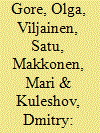| Srl | Item |
| 1 |
ID:
147435


|
|
|
|
|
| Summary/Abstract |
The oil product pricing mechanism is a regulation system that was introduced in the late 1990s to control the oil product prices in China. For the first time to our knowledge, we provide an empirical evaluation of this regulation system, with a particular focus on its role in China's macroeconomy. Based on monthly data between 2000 and 2013, we find that: (i) contrary to the general public's impression, the mechanism is ‘fair’ overall in the sense that it responds to the rise and fall of international oil price symmetrically; (ii) the effect of the mechanism on the Chinese economy, however, is very limited; and (iii) the limited effect of the mechanism holds for different levels of regulation during the studied period, suggesting that potential deregulation may have little impact on the economy.
|
|
|
|
|
|
|
|
|
|
|
|
|
|
|
|
| 2 |
ID:
166938


|
|
|
|
|
| Summary/Abstract |
China has undertaken measures to regulate the prices of petroleum products since 1998 in order to deal with the world oil price shocks on its macro-economy. However, the effects of price regulation are yet unknown, especially when the world oil price fluctuates in different regimes. The study first analyses the mechanisms of petroleum product price (PPP) regulation (in the case of gasoline) and the crude oil-gasoline price fluctuation transmission, followed by the identification of regimes and their time intervals using regime-switching vector autoregressive model, and then estimates the effects of gasoline price regulation in reducing macroeconomic volatility. It is found that the world crude oil fluctuates in different regimes (the mild-fluctuation regime and the violent-fluctuation regime), the PPP regulation can reduce oil price volatility and then macroeconomic volatility, but it is more effective in the mild-fluctuation regime. The findings present a deeper understanding of the stabilization effect of PPP regulation on the macroeconomy, provide an evidence for sustaining China's PPP regulation for the purpose of macroeconomic stability, and offer policymakers new information for petroleum product pricing reforms.
|
|
|
|
|
|
|
|
|
|
|
|
|
|
|
|
| 3 |
ID:
105752


|
|
|
|
|
| Publication |
2011.
|
| Summary/Abstract |
Nordic residential electricity consumers can now choose among a number of contracts and suppliers. A large number of households have continued to purchase electricity from the incumbent supplier at default contract terms. In this paper, we compare the situation for such passive customers. Danish default prices are regulated whereas default prices in the other countries are unregulated. Systematic price differences exist among the Nordic countries. However, as wholesale prices sometimes differ the gross margin is a more relevant indicator. Regulated gross margins are lower in Denmark than in Sweden but higher than in Norway and Finland. Because of market design Norwegian default contracts are competitive whereas Swedish contracts provide the retailer with some market power. We interpret the low Finnish margins as a result of municipal retailers continuing traditional pricing from the monopoly period. Danish margins are higher than the competitive Norwegian margins but are earned from a much lower level of consumption. The annually margins earned per consumer are very close in the two countries, which indicates that the Danish regulation is achieving its objective of approaching competitive prices.
|
|
|
|
|
|
|
|
|
|
|
|
|
|
|
|
| 4 |
ID:
111372


|
|
|
|
|
| Publication |
2012.
|
| Summary/Abstract |
Russia commenced liberalization of electricity prices in 2007 increasing the liberalization rate by 10-25% every six months. It was planned to reach full liberalization by 2011. Currently, the degree of liberalization is uncertain because of intense price regulation and a highly concentrated market in the hands of four large generating companies. Increased regulation and further consolidation may drive the market towards its pre-reform state. This paper analyses the competitive landscape of the Russian electricity market by assessing the ownership structure of electricity generation, price drivers, and government involvement in the electricity wholesale market in Russia. The main research question is why the targeted level of market liberalization has not been fully achieved in the Russian electricity market.
|
|
|
|
|
|
|
|
|
|
|
|
|
|
|
|
| 5 |
ID:
169901


|
|
|
|
|
| Summary/Abstract |
Russian government sanctioned the first gas trade at the Saint-Petersburg International Mercantile Exchange (SPIMEX) in 2012 as a part of the gas industry national strategy.
|
|
|
|
|
|
|
|
|
|
|
|
|
|
|
|